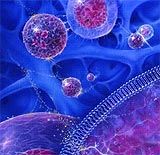Amazing story.
His cell was infested with rats, which he had to kill himself using a broomstick.
One of the hurdles of realizing the promise of nanoparticles is that scientists can’t view where they go or how the nanoparticles interact with structures once they are inside of the body. A new technique that involves injecting an acrylamide hydrogel into organs and tissues removed from mice allows researchers to image nanoparticles more than 25 times deeper than is possible with current methods, to a depth of more than 1 millimeter. Lipids are what cause tissues to look opaque. By using the hydrogel to bind all of the molecules together except for lipids, which washed away easily, the team, led by Warren C. W. Chan, were able to make the tissues look transparent but remain intact. The work, published in ACS Nano, may help researchers be able to tell if therapy-loaded nanoparticles are delivering the cargo to the desired destination. Check out the video below.
ExclusiveTechnologies.
Today’s emergence of nano-micro hybrid structures with almost biological complexity is of fundamental interest. Our ability to adapt intelligently to the challenges has ramifications all the way from fundamentally changing research itself, over applications critical to future survival, to posing small and medium as well as truly globally existential dangers.

In this article I publish suppressed information that has been actually officially published, but is effectively kept unavailable (after being rejected from all higher impact factor journals in the relevant fields because the text is too critical, it was officially published [1], but the title, corresponding author list and text was altered, no proof copy having been given to the actual author, and it can also not be as normally downloaded, even for researchers who should have access. Since this text is highly interesting and relevant far beyond the narrow engineering sciences, I allow myself to actually publish the most interesting and critical parts (slightly edited) in a series of short posts. If citing, please cite [1] anyway in order to support the author.)
Nice!!!!
Develop microscopic vehicles that can carry anti-cancer drug molecules to affected cells
Indian scientists are closing in on a breakthrough in cancer treatment that will see a variety of cancers being cured using just a series of injections without side-effects on the body, that is characteristic of chemotherapy. The new technology has the potential to completely bypass chemotherapy.
A team of scientists from the Indian Institute of Science (IISc) in Bengaluru are on the verge of developing just such a non-invasive technique to deal with cancers.
Posted in futurism
or chroma keying, is a special effects / post-production technique for compositing (layering) two images or video streams together based on color hues (chroma range). The technique has been used heavily in many fields to remove a background from the subject of a photo or video – particularly the newscasting, motion picture and videogame industries.
Abstract: Physicists at the Swiss Nanoscience Institute and the University of Basel have succeeded in measuring the very weak van der Waals forces between individual atoms for the first time. To do this, they fixed individual noble gas atoms within a molecular network and determined the interactions with a single xenon atom that they had positioned at the tip of an atomic force microscope. As expected, the forces varied according to the distance between the two atoms; but, in some cases, the forces were several times larger than theoretically calculated. These findings are reported by the international team of researchers in Nature Communications.
Making Holographic Apps more secured and efficient.
Since its birth, holograms have been extensively used to serve security systems and related purposes. The making of a hologram, dissecting it to pieces and again rejoining the blocks involves a steady orientation of lenses which encodes the information with depth perception that could be deciphered later according to requirement.
It’s hard to imagine a 21st century city running smooth without an immense use of holograms, small or big sized 2D cards with 3D engraved pictures that are present in credit cards, grocery objects, books, biomedical devices and in other objects requiring retrievable information to be stored.
In terms of concealing product information, these sticker based fancy stuffs were up to the mark, until technology escalated beyond imagination. Even a previously measured safe encryption suffered from threat and these tools became fragile. Researchers initialized various approaches to hit the safest and complex path, among which nanotechnology had an answer in store for them. A research team from the Harvard John A. Paulson School of Engineering and Applied Sciences had recently forced polarization to concise holograms, comprising of tiny light-polarization sensitive nanostructures to generate numerous ones depending upon the polarization configuration of light.
A team led by scientists at the National Institutes of Health (NIH) has reported a research trifecta. They discovered a new vulnerable site on HIV for a vaccine to target, a broadly neutralizing antibody that binds to that target site, and how the antibody stops the virus from infecting a cell. The study was led by scientists at the Vaccine Research Center (VRC) of the National Institute of Allergy and Infectious Diseases, part of NIH.
The new target is a part of HIV called the fusion peptide, a string of eight amino acids that helps the virus fuse with a cell to infect it. The fusion peptide has a much simpler structure than other sites on the virus that HIV vaccine scientists have studied.
The scientists first examined the blood of an HIV-infected person to explore its ability to stop the virus from infecting cells. The blood was good at neutralizing HIV but did not target any of the vulnerable spots on the virus where broadly neutralizing HIV antibodies (bnAbs) were known to bind.